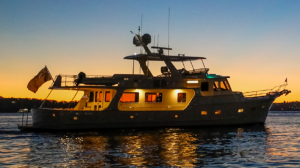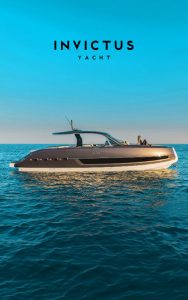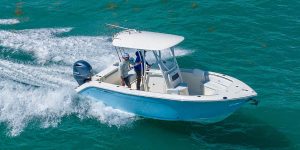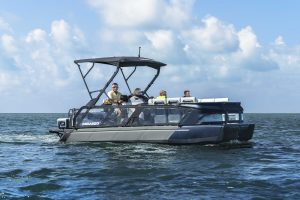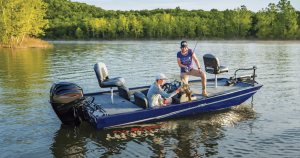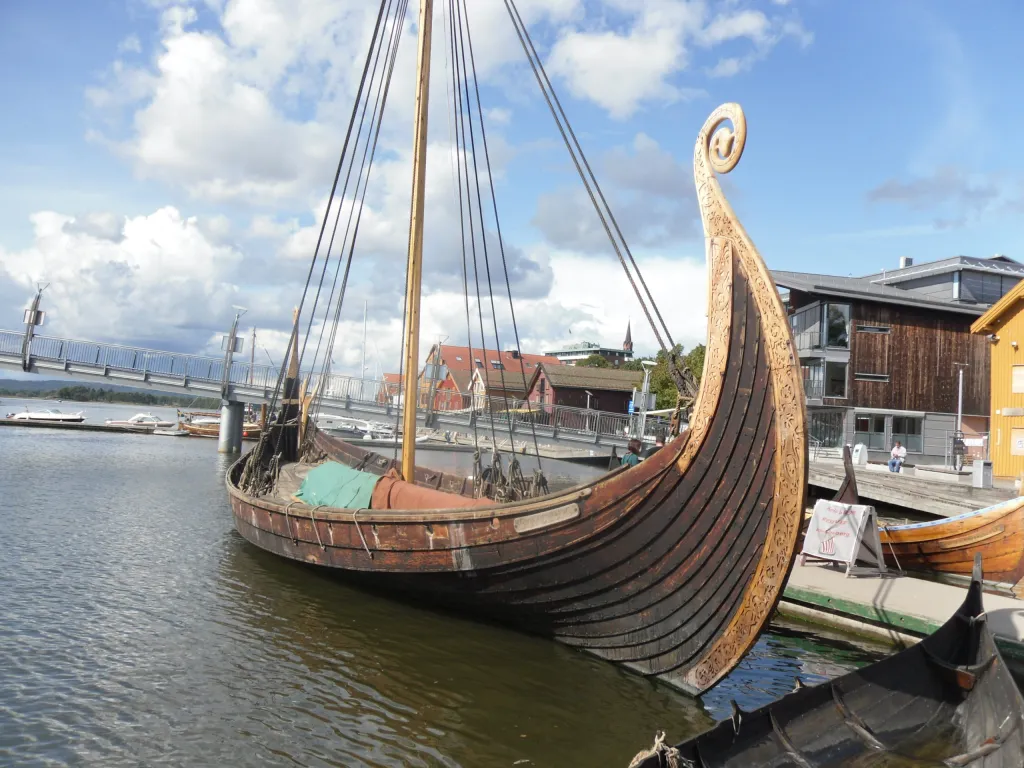
Grand Banks Yachts
The Grand Banks is a region of underwater plateaus located off the coast of Newfoundland in the North Atlantic Ocean. This area is well known for its abundant aquatic life and historical significance, as it served as a prominent fishing ground for numerous nations throughout history. The cold Labrador Current, along with the warmer Gulf Stream, converge in this region, creating an ideal environment for nutrient-rich waters, which attracts a wide variety of marine species.
The Grand Banks was a critical source of fish, particularly Atlantic cod, for European countries in the 15th century. Throughout the centuries, the fishing industry in the region expanded, leading to the rise of major fishing ports. However, excessive fishing practices have depleted cod populations in recent decades. Aside from fisheries, the region is now a significant focus of petroleum exploration due to the potential for lucrative hydrocarbon deposits.
Key Takeaways
- The Grand Banks is a nutrient-rich area in the North Atlantic that has been historically important for the global fishing industry.
- Cold and warm currents converge in this region, creating an ideal environment for marine life, such as Atlantic cod.
- In recent years, petroleum exploration in the area has gained prominence, adding a new facet to the region's economic importance.
Geographical Location
Atlantic Ocean
The Grand Banks are located in the western Atlantic Ocean, off the eastern coast of North America. With a vast area spanning approximately 282,500 square kilometers, they form one of the richest fishing grounds in the world. The Grand Banks are a part of the larger North American Continental Shelf.
North American Continental Shelf
The North American Continental Shelf is a broad, submerged platform that extends from the eastern coast of the continent to the edge of the deep ocean floor. The Grand Banks specifically lie in the Newfoundland and Labrador region of Canada, where the Labrador Current and the Gulf Stream meet.
Separate Banks
The Grand Banks consist of a series of separate banks or shallow regions, such as the Flemish Cap, St. Pierre Bank, and Sackville Spur. These banks are characterized by a mixture of cold and warm ocean currents, which promotes the growth of plankton, attracting a diverse range of marine life.
Fog and Icebergs
The presence of fog and icebergs is common in the Grand Banks. This is due to the interaction of the cold Labrador Current, which originates from the Arctic Ocean, and the warm Gulf Stream, which travels northward from the Gulf of Mexico. This interaction results in the formation of fog and gives rise to the treacherous icebergs known to frequent the area. Navigating through these conditions requires both skill and caution.
Historical Significance
The Grand Banks, located off the coast of Newfoundland, has played a crucial role in shaping the maritime and geological history of Canada. This region has been home to numerous events and developments, from the arrival of John Cabot in 1497 to the discovery of significant petroleum systems.
John Cabot, an Italian explorer sailing on behalf of England, is famously known for arriving on the shores of Newfoundland and is often credited with discovering the Grand Banks in his search for a westward route to Asia. Over time, the region gained importance due to its abundant fishing grounds which attracted fishers and settlers, establishing the Grand Banks as a vital fishing area in Canada's history.
In terms of geological history, the Grand Banks has had a diverse and complex developmental journey. The study of floodplain formation processes has expanded our understanding of the prehistoric periods related to middle Holocene hunter-gatherers and late Holocene horticulturalists. Additionally, the area has witnessed various depositional episodes and Cretaceous sequences, as detailed in the Mesozoic and Cenozoic history of the Grand Banks.
Another significant event in the history of the Grand Banks is the 1929 earthquake, landslide, and tsunami, which had a lasting impact on the study of geology and understanding of natural disasters. The event led to the first unequivocal recognition of a landslide-triggered tsunami and turbidity current, as documented in the analysis of multibeam seafloor imagery.
Furthermore, the Grand Banks has been the site of major petroleum discoveries. The significant Egret-Hibernia petroleum system found within the Labrador–Newfoundland shelf has led to the development of the Grand Banks as an important region in the oil exploration industry, as described in a geoscience publication.
To sum up, the historical significance of the Grand Banks is evident through various aspects, including its maritime history linked to John Cabot and the fishing industry, its geological developments, and its importance in the oil exploration sector. Through these various lenses, it is clear that the Grand Banks has played a crucial role in shaping the story of Newfoundland and Canada as a whole.
Aquatic Life
Cod Fishing
The Grand Banks region, located off the coast of Newfoundland, is known for its diverse aquatic life and abundance of nutrients, which attract numerous marine species. One of the most significant fish species found in the area is the Atlantic Cod (Gadus morhua). Historically, the waters around the Grand Banks have supported one of the world's greatest natural resources: the cod fishery.
However, overfishing has led to a serious decline in cod populations over the years. This has prompted great concern for the future of cod stocks in the area, especially as the stocks have struggled to recover even after the implementation of fishing restrictions.
Flatfish, Herring and Mackerel
In addition to cod, the Grand Banks is home to other valuable fish species such as flatfish (e.g., flounder and halibut), herring, and mackerel. Many of these species are vital for both the local fishing industry and marine life food chain.
For instance, the thorny skate (Amblyraja radiata) is an important fish found in the southern Grand Banks and serves as prey for larger fish species such as cod. It is essential to maintain a balance between these species, as removing one can negatively impact the entire ecosystem.
Lobster Harvesting
Lobster is another popular marine species that thrives in the nutrient-rich waters of the Grand Banks. The region's unique ecosystem supports the growth and distribution of lobsters, making it an ideal location for lobster harvesting. Lobsters play a significant role in the area's fishing industry, as they contribute to the local economy and provide a source of nutritious and high-quality seafood.
In summary, the Grand Banks is home to a diverse array of aquatic life, including cod, flatfish, herring, mackerel, and lobsters. However, overfishing poses a threat to the delicate balance of the marine ecosystem. Conservation efforts and sustainable fishing practices are critical to preserving the rich aquatic life in this region for future generations to enjoy.
Petroleum Exploration
Hibernia
The Hibernia oil field, located in the northern Grand Banks area, offshore eastern Canada, is a significant petroleum system named Egret-Hibernia(!) responsible for the discovery of 3.25 billion BOE in the Labrador-Newfoundland shelf source. This petroleum system is characterized by its geological formation, which plays a vital role in hydrocarbon accumulation and production. The exploitation of resources at Hibernia has significantly contributed to the growth of the local economy and the advancement of petroleum exploration in other regions of the Grand Banks area.
- Geological Formation: Hibernia's structure consists of a series of reservoirs within the Early Cretaceous Jeanne d'Arc Formation.
- Production Capabilities: The Hibernia oil field has remained highly productive since it began production in 1997, thanks to its exceptional reservoir characteristics.
Terra Nova
Terra Nova is another offshore oil field situated within the Grand Banks area of Newfoundland. Its exploration plays an integral part in the overall petroleum landscape of this region. The field's structural characteristics and geological setting are key factors in the efficiency of oil recovery and the ongoing petroleum exploration in Terra Nova.
- Geological Formation: Terra Nova is embedded within the Late Jurassic-Early Cretaceous Jeanne d'Arc Formation, similar to the Hibernia oil field.
- Production Capabilities: The Terra Nova production facilities began their operations in 2002, yielding a substantial amount of oil over the years.
Both Hibernia and Terra Nova hold significant proportions of petroleum reserves within the Grand Banks area and serve as important contributors to the petroleum exploration and production efforts in Newfoundland. Their diverse geological formations and production capabilities shape the petroleum systems in these regions and reflect the potential for further exploration in the Grand Banks area.
Grand Banks Yachts
Speed and Displacement
Grand Banks Yachts are known for their exceptional speed and displacement capabilities. The Grand Banks 42 Classic has a displacement of around 34,000 pounds, providing a smooth and stable ride. The Grand Banks 43 Eastbay SX and Grand Banks 49 Eastbay HX, on the other hand, offer incredible top speeds of up to 32 knots. These yachts are designed with the perfect balance between speed and stability, ensuring a comfortable sailing experience.
Design and Bulkheads
One of the key features of Grand Banks Yachts is their meticulous design and use of bulkheads. Bulkheads play a crucial role in maintaining the yacht's structural integrity, as well as protecting the salon and other living spaces. In addition, the Grand Banks Yachts design philosophy focuses on providing ample living space without compromising on performance. The Grand Banks 65 Aleutian RP, for example, features multiple bulkheads to create a safe and comfortable environment for its passengers.
Classic and Eastbay Models
Grand Banks Yachts offers a variety of models, including both Classic and Eastbay series. The Classic models, such as the Grand Banks 36 Classic, are renowned for their timeless design and trawler-style appearance. These models are perfect for those seeking a traditional, yet luxurious cruising experience.
On the other hand, the Eastbay series, which includes the Eastbay 39SX, Eastbay 38 EX, and Eastbay 45 SX models, are designed for those who prefer a sportier and more performance-oriented yacht. These models feature a sleeker design, infused hull, and advanced engineering to accommodate higher speeds and improved handling.
Overall, Grand Banks Yachts are known for their elegant design, exceptional speed and displacement, and variety of models to suit the needs of different sailing enthusiasts. With a focus on luxurious comfort and durability, these yachts provide a truly unparalleled experience on the open water.
Ocean Ranger Disaster
The Ocean Ranger was a semisubmersible offshore oil drilling rig that capsized and sank on the Grand Banks in February 1982. This disaster is considered the worst maritime accident in Canadian history since World War II. At the time, the rig was conducting oil-drilling operations for companies like the Ocean Drilling Exploration Company (ODECO) in the hostile offshore environment off of Newfoundland.
During the days of February 14-16, 1982, a typical winter storm passed over the Grand Banks. Wind speeds reached up to 70 knots and gusts up to 90, while wave heights were also extreme. The storm was so severe that it overwhelmed the rig's ability to stay afloat in the harsh conditions. Tragically, the Ocean Ranger capsized and sank, resulting in the loss of all crew members onboard.
In the aftermath of the disaster, an investigation revealed several vulnerabilities and shortcomings in the rig's design and safety mechanisms. Among them were the rig's ballasting system and the crew's general lack of emergency preparedness. The Hydrodynamic model studies of the Ocean Ranger marine disaster mentioned that most of the information on the conditions and problems encountered that day on the rig came mainly through internal walkie talkies communication.
As a response to the tragedy, companies operating in the offshore drilling business, including ODECO, had to reevaluate their safety procedures and rig designs to prevent such accidents from occurring in the future. This event also led to the establishment of new regulations and standards for the industry, aiming to improve overall operational safety and mitigate the risk associated with offshore drilling.
The Ocean Ranger disaster serves as a sobering reminder of the inherent risks and challenges associated with oil exploration in the ocean, and specifically, the Grand Banks region. The lessons learned from this catastrophe remain relevant and have been instrumental in shaping today's offshore drilling industry.
Frequently Asked Questions
How much does a Grand Banks 85 cost?
The Grand Banks 85 is a luxury yacht, and its cost can vary depending on the model year and customization options. Prices for new yachts can be obtained from authorized Grand Banks dealers or by visiting the Grand Banks website.
What is the difference between the Grand Banks 54 and 60?
The Grand Banks 54 and 60 are both luxury motor yachts but differ in size and specifications. The Grand Banks 60 is a larger yacht, with an overall length of 60 feet, while the Grand Banks 54 is slightly smaller at 54 feet in length. Each model offers unique features and customization options to suit the preferences of buyers.
Are there any used Grand Banks trawlers for sale by owner?
Used Grand Banks trawlers can sometimes be found for sale by individual owners. Potential buyers can search online forums, classified ads, and websites dedicated to yacht sales to find listings of used Grand Banks trawlers. It is important to carefully inspect any used yacht before purchase and enlist the help of a qualified marine surveyor to ensure the vessel's condition is satisfactory.
What is the Grand Banks Express model?
The Grand Banks Express model is part of their Heritage series, a line of luxury motor yachts characterized by their timeless design and exceptional build quality. These yachts feature a semi-displacement hull, offering a comfortable cruising experience with impressive fuel efficiency. They are known for their spacious interiors and excellent handling, making them perfect for long-range cruising.
Where are Grand Banks yachts built?
Grand Banks yachts are built at their manufacturing facility in Malaysia. The company has a long history of producing high-quality yachts using both traditional craftsmanship and modern technology. This combination ensures that each Grand Banks yacht meets the highest standards of performance, safety, and luxury.
When did Grand Banks start using fiberglass in their boats?
Grand Banks began using fiberglass as a construction material for their boats in the early 1970s. Transitioning from traditional wood construction, fiberglass offered several advantages, including increased strength, decreased weight, and improved resistance to water damage. Since then, Grand Banks has continued to innovate, utilizing advanced materials and construction techniques to create high-quality yachts that stand the test of time.






